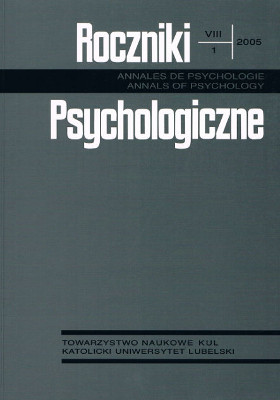Religious feelings in preschool children in self-reports and in reports of their mothers
Abstract
The study concerns religious feelings in preschool children as reported by the children and by their mothers. 90 children at the ages 4, 5 and 6 were studied by means of a picture method and interviews with their mothers were carried out. The paper includes a contents analysis of the representations of religious feelings in children as well as a comparison of the data from children and their mothers with the focus on both the contents and the way of expressing the feelings reported. The relationships between positive and negative feelings are discussed and more detailed statistical analysis was applied to negative feelings. It was found that on the level of general tendencies the both sources of reports concerning children's religious feelings showed similar quality. A more detailed analysis discovered certain minor differences, however, the data from the two sources were complementary rather than contradictory.
References
Aranowska, E. (1992). Związki między zmiennymi w interpretacji analizy składowych głównych i analizy korespondencji. W: E. Aranowska (red.), Wybrane problemy metodologii badań (s. 133-168). Warszawa: UW.
Czapiński, J. (1988). Wartościowanie. Efekt negatywności. (O naturze realizmu). Wrocław−Warszawa−Kraków−Gdańsk−Łódź: Ossolineum.
Fisher, K. W., Shaver, P. R., Carnochan, P. (1990). How emotion develop and how they organize development. Cognition and Emotion, 4, 81-127.
Frijda, N. H. (1989). Prawa emocji. Nowiny Psychologiczne, 61, 2, 24-49.
Frijda, N. H. (1992). The empirical status of the laws of emotion. American Psychologist, 43, 349-358.
Gasiul, H. (2002). Teorie emocji i motywacji. Rozważania psychologiczne. Warszawa: Wyd. UKSW.
Gębarski, K. (1968). Elementarne metody grupowania zmiennych. Biuletyn Psychometryczny, 2, 145-174.
Goldberg, L. R. (1968). Simple models or simple process? Some research on clinical judgments. American Psychologist, 23, 483-496.
Jarosz, M. (2003). Interpersonalne uwarunkowania religijności. Lublin: TN KUL.
Jarymowicz, M. (1998). Uczucia. W: W. Szewczuk (red.), Encyklopedia psychologii (s. 929-935). Warszawa: Wyższa Szkoła Ekonomiczno-Społeczna.
Kowalczyk, S. (1990). Zarys filozofii człowieka. Sandomierz: Wyd. Diecezjalne.
Mańkowska, M., Tatala, M. (2002). Uczucia religijne dzieci przedszkolnych w świetle ich własnych wypowiedzi oraz w percepcji matek. W: Psychologia w perspektywie XXI wieku. XXXI Zjazd Naukowy Polskiego Towarzystwa Psychologicznego, Lublin, 5-8 września 2002 (s. 335). Lublin: TN KUL.
Niemirowski, T. (2004). Specyfika wyjaśniania rozwoju świadomości religijnej. Psychologia Rozwojowa, 9, 1, 79-86.
Norusis, M. J. (1990). SPSS/PS+ 4.0 Base manual for the IBM PC/XT/AT and PS/2. Chicago: SPSS Inc.
Olechnowicz, H. (2000). Kształtowanie uczuciowości wyższej a wczesne zapobieganie niekontrolowanej agresywności. Nowiny Psychologiczne, 2, 17-23.
Reber, A. (2000). Słownik psychologii (s. 789-790). Warszawa: Wyd. Naukowe SCHOLAR.
Reykowski, J. (1992). Procesy emocjonalne. W: T. Tomaszewski (red.), Psychologia ogólna (s. 7-58). Warszawa: Wyd. Naukowe PWN.
Socha, P. (1996). What do we know and what we would like to know about religious feelings? Polish Quarterly of Developmental Psychology, 2, 127-130.
Szymołon, J. (2003). Koncentracja na sobie a religijność. W: P. Francuz, M. Grygielski, W. Otrębski (red.), Studia z psychologii w Katolickim Uniwersytecie Lubelskim (t. 11, s. 39-49). Lublin: Wyd. KUL.
Tatala, M. (2000). Rozwój uczuć religijnych dzieci przedszkolnych. Lublin: RW KUL.
Walesa, Cz. (1998). Struktura religijności człowieka. Analiza psychologiczna. Zeszyty Naukowe KUL, 41, 3-4, 3-48.
Walesa, Cz. (2003a). Religijności rozwój. W: T. Gadacz, B. Milerski (red.), Religia. Encyklopedia PWN (t. 8, s. 423-427). Warszawa: Wyd. Naukowe PWN.
Walesa, Cz. (2003b). Wyjaśnianie religijności człowieka (analiza psychologiczna). W: P. Francuz, M. Grygielski, W. Otrębski (red.), Studia z psychologii w Katolickim Uniwersytecie Lubelskim (t. 11, s. 21-38). Lublin: Wyd. KUL.
Copyright (c) 2005 Roczniki Psychologiczne

This work is licensed under a Creative Commons Attribution-NonCommercial-NoDerivatives 4.0 International License.


